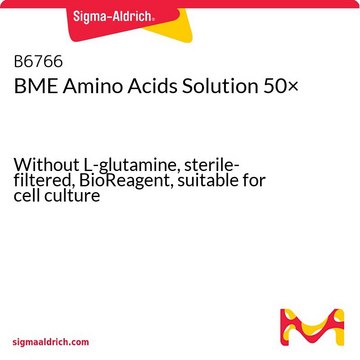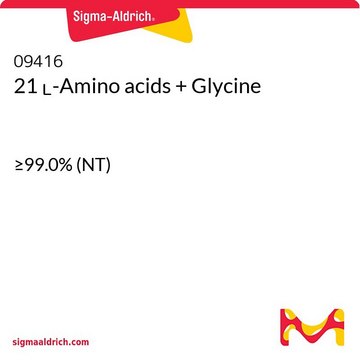Wszystkie zdjęcia(1)
Kluczowe dokumenty
R7131
RPMI 1640 Amino Acids Solution (50×)
Without L-glutamine, sterile-filtered, BioReagent, suitable for cell culture
Synonim(y):
Amino Acid Supplement
Zaloguj sięWyświetlanie cen organizacyjnych i kontraktowych
About This Item
Kod UNSPSC:
12352209
NACRES:
NA.75
Polecane produkty
Poziom jakości
sterylność
sterile-filtered
linia produktu
BioReagent
Formularz
liquid
metody
cell culture | mammalian: suitable
zanieczyszczenia
endotoxin, tested
Warunki transportu
ambient
temp. przechowywania
2-8°C
Opis ogólny
RPMI 1640 Amino Acids Solution (50×) serves as an amino acid concentrate to supplement Roswell Park Memorial Institute medium (RPMI)-based mammalian cell culture media.
Zastosowanie
RPMI 1640 Amino Acids Solution (50×) has been used as a supplement:
- in M9 minimal medium to culture the bacterial strains, SX701 and JE116
- to culture blood neutrophils from lactation cows in vitro
- for amino acid stimulation in amino-acid-free Roswell Park Memorial Institute medium (RPMI) medium to grow HeLa cells
Ta strona może zawierać tekst przetłumaczony maszynowo.
suplement
Kod klasy składowania
10 - Combustible liquids
Klasa zagrożenia wodnego (WGK)
WGK 1
Temperatura zapłonu (°F)
Not applicable
Temperatura zapłonu (°C)
Not applicable
Wybierz jedną z najnowszych wersji:
Masz już ten produkt?
Dokumenty związane z niedawno zakupionymi produktami zostały zamieszczone w Bibliotece dokumentów.
Klienci oglądali również te produkty
Nuno Carinhas et al.
BMC systems biology, 5, 34-34 (2011-03-01)
Stoichiometric models constitute the basic framework for fluxome quantification in the realm of metabolic engineering. A recurrent bottleneck, however, is the establishment of consistent stoichiometric models for the synthesis of recombinant proteins or viruses. Although optimization algorithms for in silico
D Kazyken et al.
The Journal of biological chemistry, 297(4), 101100-101100 (2021-08-22)
The mechanistic target of rapamycin (mTOR) complex 2 (mTORC2) signaling controls cell metabolism, promotes cell survival, and contributes to tumorigenesis, yet its upstream regulation remains poorly defined. Although considerable evidence supports the prevailing view that amino acids activate mTOR complex
Preeti Ashok et al.
Frontiers in bioengineering and biotechnology, 8, 571425-571425 (2020-11-17)
Functional heart cells and tissues sourced from human pluripotent stem cells (hPSCs) have great potential for substantially advancing treatments of cardiovascular maladies. Realization of this potential will require the development of cost-effective and tunable bioprocesses for manufacturing hPSC-based cell therapeutics.
Piero Dalle Pezze et al.
Nature communications, 7, 13254-13254 (2016-11-22)
Amino acids (aa) are not only building blocks for proteins, but also signalling molecules, with the mammalian target of rapamycin complex 1 (mTORC1) acting as a key mediator. However, little is known about whether aa, independently of mTORC1, activate other
Daniel Bloch Hansen et al.
The Journal of membrane biology, 245(2), 77-87 (2012-03-03)
The present work was initiated to investigate regulation of the taurine transporter TauT by reactive oxygen species (ROS) and the tonicity-responsive enhancer binding protein (TonEBP) in NIH3T3 mouse fibroblasts during acute and long-term (4 h) exposure to low-sodium/hypo-osmotic stress. Taurine
Nasz zespół naukowców ma doświadczenie we wszystkich obszarach badań, w tym w naukach przyrodniczych, materiałoznawstwie, syntezie chemicznej, chromatografii, analityce i wielu innych dziedzinach.
Skontaktuj się z zespołem ds. pomocy technicznej










